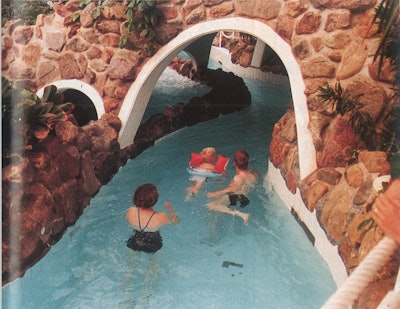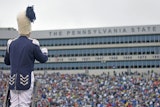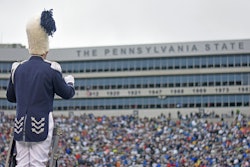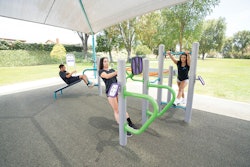
This article originally appeared in the October 1989 issue of AB with the headline, “A New Splash at Colleges.”
A new trend in aquatic recreation—the leisure pool—has been making its way into municipal and county indoor recreation complexes for a number of years, but now leisure pools also seem poised for entry into the college environment.
Originated and developed in Western Europe, and popular in the Scandinavian countries as well, the leisure pool consists of a free-form body of shallow water—with a maximum depth of 4 feet—that features waterfalls, bubble benches, spiraling water tubes, raindrops, channels of rushing currents, lazy vortexes, whirlpools and, in some cases, small wave pools.
Recently, two American universities began drawing up plans for innovative water recreation areas on their campuses. In each case, the smaller leisure pool is coupled with a conventional short-course competition pool, which is necessary for fitness lap swimming, varsity competitive programs and swimming classes at varying skill levels.
The two types of pools provide a comprehensive and balanced program for organized activities, special events and recreation. Socializing is the new product, especially since swimming for exercise is a lonely activity unless the swimmer is having fun with others. With its underwater benches and alcoves, the leisure pool provides active sport as well as passive fun.
The goal of the two universities developing aquatic complexes with leisure pool provides active sport as well as passive fun.
The goal of the two universities developing aquatic complexes with leisure pools is to create a social center for students to interact with other student both in and out of the water. As the stress level on campuses continues to escalate, there is an increasing awareness by administrators that students want and need healthy recreation in their lives. Not only is this a current need, but participation in recreation can pay dividends in good health throughout the remainder of an individual’s life.
As more schools are making the decision to add health, physical education and recreation centers as a means of providing a greater variety of recreation for their students, trends are being studied and evaluated. Modern college recreation facilities can attract many applicants. To a high school senior who has a high anxiety level about leaving home for a big university, seeing a recreation center, especially a new on, has a reassuring impact. The recreation enter may be seen not only as a place for relaxation, but as a place to meet other students outside of the classroom. When a decision comes down to two schools, attractive recreation facilities can sometimes make the difference.
If a university or college decides to commit to a new HPER building, it will very likely contain a natatorium. If it does, that aquatic center will predictably be used for 75 years and, if properly designed, 100 years. With that overview, it’s understandable that those responsible will want to investigate the new trend in aquatic recreation, which appears to be a combination of a conventional swimming pool and a social leisure pool.
The character and systems in any new aquatic center on a college campus are quite different than those created only a decade ago. Today, major emphasis is placed upon the design, configuration, materials and coating systems, as well as mechanical dehumidification, fenestration (the arrangement of windows and doors), chemical treatment and automatic control.
What is a leisure pool? In an adjacent space near the competition pool, a modern version of the ‘ol swimming hole takes form, limited only by the imagination of the designer. One continuous free-form pool of water, sparkling clear and lapping at its perimeter, invites all those nearby to sample the experience. Common features include recessed stairs, a zero-depth beach area and shallow warm water that meanders through a narrow channel where the current quickens and then disappears, only to erupt again after an unknown interval.
The channel of white water briskly carries the swimmers along a short flume that spirals to an end in a mild vortex surrounded by a barrier wall between the high activity area and a tranquil pool. The tranquility is interrupted occasionally by several sparges that douse the swimmers with warm and cold water at intermittent periods, as if controlled by a capricious gremlin.
The bubble bench is another exciting experience. Constructed of concrete and tile and taking the configuration of either an underwater bench or a rolling chaise lounge, it erupts in a matrix of bubbles when powered by an air blower as part of the mechanical system.
One of several focal points is the whirlpool, elevated approximately 18 inches from the surrounding deck and featuring an entry stair with the necessary handrail. This elevated whirlpool avoids the psychological experience of sitting in a hole in the ground.
If the proposed leisure swim center is to follow the European example, an entry pool will be created adjacent to a glass exterior natatorium wall and will be connected by a water channel to a small outdoor pool for use year-round. This indoor/outdoor pool is heated 12 months, just like indoor pools.
The final climax of this aquatic escape may be an enclosed slide ride that is reached by walking through a tunnel that connects the natatorium to an enclosed stair tower. At the top is the entry level for the trip through a fiberglass tube that spirals and plunges downward and then finally enters the natatorium through a wall, discharging its riders with a splashdown into a catch pool located near the tunnel entrance.
Important support spaces found in the aquatic centers include administration and management offices, a weight/exercise room, a control point, dressing rooms and storage, mechanical filtration and water treatment rooms.
The outdoors cannot be forgotten. A generous sundeck wrapped around an indoor/outdoor pool enhances summer school programs. Landscaping surrounding the outdoor area is the minimum treatment, while schools with major summer school programs could unveil a full-scale swimming pool complex for summer use.
Programming a university leisure swim center can be done with modification and expansion of current program disciplines. The conventional activities in the rectangular competitive pool stay quite the same. Likewise, activities that currently take place in the shallow water of the conventional pool can occur in the leisure activity free-form pool.
The real benefit to the user is the free time at the end of each season. The fun, in-the-water experience that can be sampled will serve a s a motivation and attraction to prospective users of the center. Added to this is the general good feeling of students who will identify their lifestyle with activities at the center.
Aquatic directors must understand the more sophisticated technical features of the control systems that operate leisure pools. It must be recognized that the many water features demand a significant amount of energy over and above that required by a conventional competitive pool. There are many motors that drive the pumps for the auxiliary systems, such as waterfalls, current channel inlets, air blowers, slides, fountains, whirlpools and hydrojets.
In an effort to keep these energy systems at maximum cost-efficiency, an electronic control system is necessary that programs the motors for optimum use while at the same time minimizing activity when users are at a minimum. This is accomplished with different system modes depending upon the size of crowds and the time of day.
By sequencing water systems (motors and valves), the user is directed form one water feature to the next. This gives variety to the leisure pool—as compared to all systems running continuously and at the same time—while minimizing the energy demand. Control readouts in the natatorium control office are essential for efficient management of the facility.
Energy consumption also occurs to heat the water. In this regard the European swim facility differs in some ways from the American. In the United States, the approach is to heat the contents of the pool with a heat exchanger that slowly raises the temperature of the mass of water by continual passes. The result is that there is usually no great difference in temperature between influent inlet water and the pool water.
In the leisure pool, this applies to the main recirculation system. However, special warm water features such as waterfalls, flow-through spa pools and large fountains that pour over swimmers will discharge water that is 10°F warmer than the pool water. Such a feature requires a heat exchange system that will raise the water temperature the necessary amount in one pass over the heating elements.
The aquatic recreation center will soon begin to take its place on the campus landscape. The result will be better and more popular programs and a definite draw to prospective students.
Success in such a project will depend on the definition of the word, which may vary between administrators. It can be predicted, however, that a leisure swim center will provide students with a change of pace and a social environment that is wholesome and fun at the same time.




































